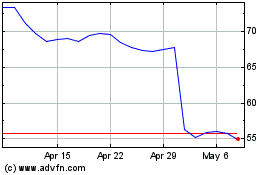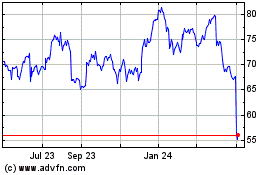Credit Markets Show Signs of Stabilizing After Historic Fed Intervention
April 06 2020 - 5:59AM
Dow Jones News
By Sam Goldfarb and Anna Hirtenstein
Key parts of the U.S. debt markets are functioning again, a sign
the Federal Reserve's extraordinary steps are easing a credit
market crunch.
Investors say the Fed has reduced disruptions in the $17
trillion U.S. Treasurys market that had sent shock waves through
the financial system. Large businesses such as Oracle Corp. and CVS
Health Corp. are borrowing money at a record pace. Some lower-rated
companies are issuing bonds again. And increased demand for
mortgage bonds is starting to pull mortgage rates lower after they
unexpectedly rose last month.
Debt markets remain far shakier than they were about a month
ago. Most new bond sales are still coming from well-established
companies with higher credit ratings, reflecting a consensus that
the coronavirus crisis will push the economy into a deep recession.
Liquidity, or the ease with which investors can buy and sell
securities at what they think are market prices, remains poor in
some riskier corners of the market. Some worry conditions could
quickly deteriorate again, if the economic outlook darkens
further.
Still, investors and analysts say the Fed's historic
interventions have spurred a meaningful reduction in market stress.
Those include announcing plans to buy unlimited amounts of
government bonds and mortgage securities issued by
government-supported entities and starting new programs to buy
higher-rated corporate bonds.
"The liquidity side is being fixed," said Michael Collins, a
senior portfolio manager at PGIM Fixed Income.
Investors said the Fed's main goal remains simple: to hold down
borrowing costs across the economy, so individuals, businesses and
communities are encouraged to borrow and spend money. But that has
proved challenging in recent weeks, pushing the central bank to
take ever-more-aggressive and creative actions.
Shortly after the central bank reduced the key interest rate it
controls to near zero on March 15, yields on longer-term U.S.
Treasurys shot upward, with the 10-year yield climbing to 1.259%
from 0.5% the previous week. The extra yield, or spread, investors
demand to hold ultrasafe mortgage bonds over Treasurys jumped to
around 1.75 percentage points, according to Tradeweb. That is
compared with 1.52 percentage points just before the rate cut and
less than 0.3 percentage point a week earlier.
In both cases, investors said the moves were fueled by money
managers rushing to raise cash by selling what they could:
ultrasafe debt. That contributed to deteriorating liquidity, as
dealers demanded more compensation to stand in the middle of
trades.
One measure of the Fed's recent success is that the 10-year
Treasury yield has fallen back to 0.587%, as of Friday's close.
Another is that average mortgage spreads are back down to around 1
percentage point. Put together, the moves should push down mortgage
rates and hand more money to homeowners who refinance their
mortgages.
The Fed hasn't even started buying corporate bonds yet, but just
its promise to do so has already provided a lift to larger
businesses.
Last week, companies outside the financial sector, including
Oracle, Dollar General Corp. and General Mills Inc. sold a record
$104 billion of investment-grade bonds, beating the previous record
of $73 billion set the previous week. In many cases, companies have
been selling bonds at yields that were barely above those on their
existing bonds, a sign of strong demand from investors. Five
companies also issued speculative-grade bonds, kicked off by Pizza
Hut owner Yum Brands Inc., with the first high-yield bond sale
since March 4. In addition, cruise operator Carnival Corp. &
PLC -- which is investment-grade but facing urgent liquidity
pressures after it shut down operations -- sold $4 billion of
secured bonds at a hefty 11.9% yield.
The recovery has been more mixed in other areas of the credit
market. The amount of extra yield investors demand to hold
securitized debt -- backed by everything from student loans to
aircraft leases -- instead of Treasurys has generally declined in
the last two weeks. But investors say there are large variations
even within sectors, depending on how vulnerable specific borrowers
are to the economic downturn. And sales of new asset-backed
securities are likely to be on hold until the Fed starts up a
program to buy the highest-rated debt in the asset class.
Central-bank support for some short-term municipal bond prices
helped pull the market out of a major liquidity crunch that brought
state and local government borrowing to a standstill in mid-March.
Also helping: congressional endorsement of a program that would
provide liquidity for longer-dated maturities. Prices rebounded
sharply, though they later fell again. Issuance of new bonds has
increased slightly but remains around 10% of February levels,
according to Refinitiv.
A series of ratings-firm downgrades over the course of the past
week reminded investors of many issuers' vulnerability. S&P
Global on Wednesday reset its outlook to negative on all U.S.
public-finance sectors. New York's Metropolitan Transportation
Authority has frozen new projects despite billions of dollars in
planned aid.
Some investors say there is still more pain to come, regardless
of what the Fed can do to calm markets.
In many cases, companies are issuing bonds to build up their
cash reserves and try to improve their ability to weather the
crisis, said Rupert Lewis, head of European syndicate at BNP
Paribas. Companies have also been drawing down on their credit
lines en masse, putting pressure on lenders.
"There's very few companies that will be operating anywhere
close to their usual level," said James Athey, an investment
manager at Aberdeen Standard Investments. "Short term, medium term,
long term, there should be huge concerns about balance sheets and
people's ability to pay back their debt."
Heather Gillers contributed to this article.
Write to Sam Goldfarb at sam.goldfarb@wsj.com and Anna
Hirtenstein at anna.hirtenstein@wsj.com
(END) Dow Jones Newswires
April 06, 2020 05:44 ET (09:44 GMT)
Copyright (c) 2020 Dow Jones & Company, Inc.
CVS Health (NYSE:CVS)
Historical Stock Chart
From Mar 2024 to Apr 2024

CVS Health (NYSE:CVS)
Historical Stock Chart
From Apr 2023 to Apr 2024
